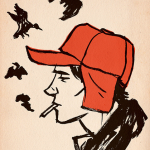Every week in The Kiddy Pool, Erin Newcomb confronts one of many issues that parents must deal with related to popular culture.
I love night running in the wintertime. I love the way my neighborhood changes in the early twilight, lit up by Christmas lights. I love taking off on a path in the woods, where the snow amplifies the moonlight and the muffled sounds transport me to Narnia. I fell in love with running long before I fell in love with my husband, long before I fell in love even with God. And, in a way, running brought me to both of them. My husband and I got to know each other through miles and miles of Pennsylvania forest punctuated by 3-mile long hills, snake encounters, and detours off the path with a bit of toilet paper. That last bit proved to me that he was a keeper—undeterred by my, um, naturalness.
Running brought me to God even before that though, as I found a peace and a beauty in the forests around me. I sought the woods at every opportunity, to run along a rushing stream, to dodge an angry flock of Canadian geese (they hiss) on a tow path, to sneak into the dirt mounds of the abandoned construction site behind the canal. My parents never knew where I explored, and my fascination with following rabbit trails, any sign of escape from the congested world around me, only deepened my faith. I sought streams and trees and animals, and when I found them, I found a transcendent beauty and serenity (what Romantic poets called the “sublime”) that solidified my certainty in the Creator before I ever had the language to describe that experience.
So when I picked up Richard Louv’s Last Child in the Woods this week, it felt like an affirmation from page one: “In nature, a child finds freedom, fantasy, and privacy: a place distant from the adult world, a separate peace.” Part narrative, part scientific study, part impassioned plea for social policy changes, Louv’s text outlines the many things that keep kids out of the wilderness (from fear of strangers and nature itself to lack of access to open spaces to shifting priorities about how children “ought” to spend their time). Yet Louv’s argument is clear and multi-faceted about why children (and all of us, really) need time with nature, where play is based on “loose parts”—creative, unstructured, not dictated by the rules and boundaries and limits of official playground equipment or toys.
Now, Louv doesn’t argue against the use of technology and media or education and institutions, but he reminds readers that those experiences are not interchangeable with nature. He documents the therapeutic, creative, and even spiritual benefits of green spaces, from rooftop gardens to sprawling forests. Lying beneath a canopy of stars or dipping into an ocean that stretches beyond the horizon cannot be simulated without losing the very sublimity that gives us a glimpse of God. Instead of encouraging fear, nature soothes anxieties and instructs us in paying attention to our surroundings. It can breed humility in the awareness of our smallness within the universe and wisdom in how to steward the awesome resources God provides. It can restore us to ourselves by removing us from ourselves. I still feel that peace, that joy, when I spend time in the woods; I breathe more easily, if only for a short time, and Louv’s book confirms my commitment to offer my daughter the chance to love nature too, and through it, to see God’s hand.











